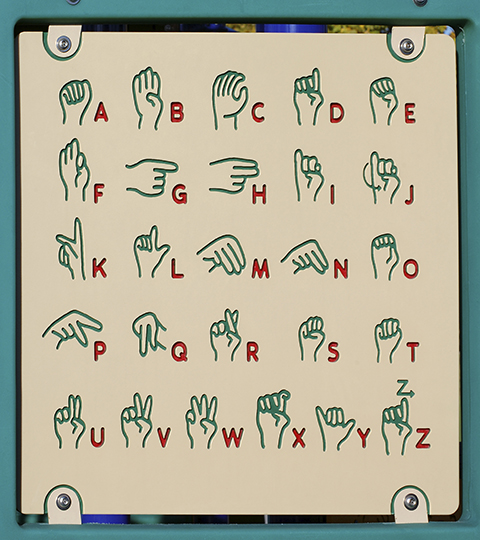 The most recent core course added to Elizabethtown College’s curriculum, shows not only the power of student initiative and the support of faculty and staff members but also the dedication of Elizabethtown College to community-based learning.
The most recent core course added to Elizabethtown College’s curriculum, shows not only the power of student initiative and the support of faculty and staff members but also the dedication of Elizabethtown College to community-based learning.
Social Participation and Communication in the Deaf Community: American Sign Language or ASL105 was approved by the College’s Academic Council and Core Committee at the end of November, but its beginnings go back more than a year to the first weeks Tyler Latshaw was on campus.
Latshaw, now a sophomore information systems major, related how, during a Student Senate retreat, just a few weeks into his first semester, Senate representatives were tasked with formulating five goals to accomplish in a year. Because his sister graduated from Elizabethtown in 2013 and now attends graduate school at Gallaudet, a liberal arts college for deaf and hard of hearing students and those who wish to learn about the culture Latshaw proposed that ASL325 (American Sign Language) become a 4-credit core course.
“I had talked to some classmates at orientation about ASL,” Latshaw said. “They wanted to take it and were disappointed when they found out it doesn’t count as a core. After that, it was constantly in the back of my mind.”
The students were very, very passionate about having the course.”
He proposed the concept, and Senate went with it. But Latshaw quickly learned, that taking inspiration to fruition can be long and arduous process.
After meeting with the College’s Core Committee chair, Latshaw was told the concept had to be proposed by a professor. And, to be a core, it needed to be four credits rather than two. This posed a challenge as the part-time ASL adjunct came to campus just once a week.
After speaking with several departments that couldn’t take the new course for one reason or another, the ad hoc committee formed by Senate to propose the course change pushed forward. “Because we were first-years, we felt that, maybe, we weren’t being taken seriously,” Latshaw said. But, rather than being discouraged by the roadblocks, the committee was spurred on. They landed at Occupational Therapy which said they’d considered the proposal. By the end of the spring semester, Latshaw had heard nothing, and there was no word over the summer. But, as soon as the members were back on campus in August, the committee checked in. “We were told that one of the professors had looked into it and decided to go with it,” said Latshaw of Nancy Carlson, associate professor of OT.
A basic ASL course had been part of the OT curriculum in earlier years, said Carlson who graduated from Elizabethtown in 1984 and took sign language as a student, but it shifted out of the department. With that in mind, the first thing she asked the students to undertake was a market analysis. The committee researched offerings and collected syllabi at other schools.
“We needed to show the importance of ASL and what other institutions (peer and aspirant) were doing,” Latshaw said. They also gathered information from Registration and Records on how fast the ASL325 class filled up each semester – “within three hours.”
“The students were very, very passionate about having the course,” Carlson said. “It’s a good fit for OT; it’s an opportunity for occupational therapy to contribute to the core.”
To bring the course to four credits, class participants apply the ASL they learn, which makes it a perfect opportunity for a Signature Learning Experience (SLE). “So,” said Latshaw, “the proposal included ASL as a course, as a (Power of Language) core and as an SLE.”
Students will learn about finger spelling, numbers, basic conversational words, history of the language — ASL is now deemed an official world language by the U.S. Department of Education — and information about the culture. “We don’t consider deafness to be a disability; we consider it a culture difference,” Carlson said. “The course takes that slant, and it makes a statement about how (Elizabethtown) thinks of people and culture and meaningful participation. The experiential learning was critical.”
After learning the basics of the visual language, students will know enough to participate in 15 hours of community-based learning, in direct contact with the deaf community. Suggested activities are to attend a deaf religious service or a lunch or coffee, volunteer or attend a hearing-loss expo. “It’s important for the students to be in the deaf community,” Carlson said. The curriculum requires 40 percent of the grade from community learning.
As the course work is interdisciplinary, the class is open to anyone as a core but it will be monitored by OT. “I had a lot of support,” Carlson said of the conversations she had before she wrote the course. “I chatted with Modern Languages folks and Education folks and the chair of the academic council and core committee, Betty Rider, my chair. They were all very supportive of a student lead project.”
On Nov. 18, the course was approved by the academic counsel and by the core committee. The first class will be available for fall 2015 or spring 2016.
“I don’t know how to feel,” said Latshaw. “I am so happy. … When I suggested it at the retreat I never expected that it actually would happen. There’s shock, amazement, confusion. All of us on the committee realize we opened doors for so many people.”
Latshaw plans to take the class if he is able to fit it into his schedule “I’d be very disappointed if I don’t get to take it.”

